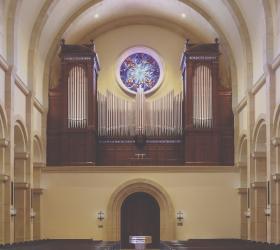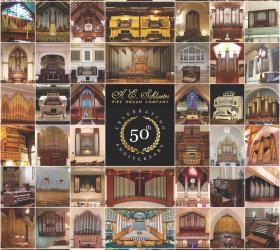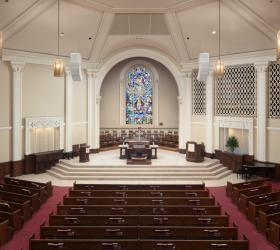
Juget-Sinclair Organbuilders,
Montréal, Québec, Opus 42
Christ the King Catholic Church,
Dallas, Texas
During a visit to his hometown of Winston-Salem, North Carolina, Henry McDowell, director of music at Christ the King Catholic Church in Dallas, visited Jack Mitchener and played his two-stop Juget-Sinclair practice organ. This piqued McDowell’s interest in the organbuilders. Shortly thereafter, he visited the workshop with Jesse Eschbach, and the ensuing dialogue began the process of commissioning the largest Juget-Sinclair organ built to date. Involved in the project were Monsignor Donald Zimmerman, pastor at Christ the King, Henry McDowell, and Jesse Eschbach, as consultant.
Envisioned was an instrument of fifty-eight stops across three manuals and pedal with mechanical action and an aesthetic of French Romantic inspiration. From the outset, there were a few design challenges that needed to be addressed. The west gallery could not support the weight of the instrument and space for the choir could not be reduced. There was ample room in the chambers alongside the gallery, but it was desired that the organ sound as directly as possibly into the nave and not as though it was speaking from
the chambers.
The plan took shape along the following lines: the Grand-Orgue and Pédale divisions would be placed on the back wall on a steel frame whose weight was not supported by the gallery. Furthermore, both the Positif and Récit divisions would be enclosed symmetrically, situated partially in the chambers, on either side of the loft. These divisions, however, were extended beyond the chambers and angled to speak more directly into the nave, the space deeper inside the chambers being reserved for the lowest octaves of the 32′ ranks. The windchests are placed on one level (with the exception of the offset chests of the Grand-Orgue), promoting more stable intonation. The console would be detached with carbon-fiber trackers running to all divisions on each of the three walls under a newly built oak floor.
The tonal aesthetic is inspired by the French Romantic tradition, but adapted for modern North American liturgical requirements, for the specific culture of the parish, and for the acoustics of the building. The reeds are brilliant, yet not overwhelming. The flues are vivid and clear, with a variety of colors, yet their power on the whole is not excessive. With reeds drawn in all divisions, the instrument delivers a French symphonic sound with glorious power and richness, profoundly undergirded by a 32′ Bombarde. Yet, for choral accompaniment, the instrument has a wide palette of rich colors and dynamics.
The church requested that the project include both a continuo organ and an antiphonal division meant to accompany the cantor. The workshop proposed that these two be combined such that the continuo organ (with flutes 8′ and 4′ and a doublette) could be playable from the main console and function as the antiphonal division. The continuo organ is softer than the gallery organ, to be certain, but it provides a delightful and effective foil to the main instrument nevertheless.
There were three further challenges to overcome for which a common solution was found: how to render the continuo instrument playable from the loft, how to lighten the key action on a rather large instrument, and how to isolate the wind supply for the bass extensions in the Pédale division. For each of these challenges electricity was the solution. The continuo organ can be connected to the Positif manual by outlets in the chancel. On the manual divisions, the lowest octaves of the 8′ and 16′ stops are winded on electro-pneumatic motors based on the nineteenth-century French Schmoll et Moll system. In the Pédale division, pipes of the extended stops are winded electro-pneumatically on individual pallets.
There was another challenge foreseen for the instrument’s installation: the sag in the steel beams that would occur once the weight of the instrument was placed on it. So, once the frame was in place, cables were anchored to the floor and the beams and brought under a tension equivalent to the weight of the instrument. Everything above the beams—casework, windchest, pipes, and wind system—was installed first, and when the beams were supporting their full weight, the cable tension was released. Once the cables were removed, everything below the beams—lower casework, trackers, and risers—was installed.
In addition to being the largest instrument built by Juget-Sinclair to date, Opus 42 is also their first instrument with three manuals, the first to have a 16′ façade, the first to use electro-pneumatic offsets in the lowest octaves, the first to be built on a steel frame, and the first new instrument to use carbon-fiber trackers. It is also the first instrument to be built with Robin Côté as a full one-third partner in the firm. Working at the shop for almost 15 years, he shared fully in the project at all levels—concept, design work, and voicing.
—David Szanto
Montréal, Québec, Canada
Grand-Orgue (Manual I)
16′ Montre
16′ Bourdon
8′ Montre
8′ Salicional
8′ Bourdon
8′ Flute harmonique
4′ Prestant
4′ Flûte ouverte
22⁄3′ Quinte
2′ Doublette
Fourniture IV
Cymballe III
Cornet V
16′ Bombarde
8′ Trompette
8′ Trompette en chamade
4′ Clairon
Positif expressif (Manual II)
8′ Principal
8′ Bourdon
8′ Dulciane
8′ Unda Maris
4′ Prestant
4′ Flûte à cheminée
22⁄3′ Nazard
2′ Doublette
13⁄5′ Tierce
11⁄3′ Larigot
Fourniture V
16′ Clarinette basse
8′ Trompette
8′ Cromorne
4′ Clairon
Tremulant
Récit expressif (Manual III)
16′ Bourdon
8′ Flûte traversière
8′ Cor de nuit
8′ Viole de gambe
8′ Voix céleste
4′ Prestant
4′ Flûte octaviante
22⁄3′ Nazard
2′ Octavin
13⁄5′ Tierce
Plein Jeu III–V
16′ Basson
8′ Trompette
8′ Basson-Hautbois
8′ Voix Humaine
4′ Clairon
Tremulant
Pédale
32′ Bourdon
16′ Contrebasse
16′ Soubasse
8′ Principal
8′ Bourdon
4′ Prestant
4′ Flûte
32′ Bombarde
16′ Bombarde
8′ Trompette
Couplers
II/I – III/I – III/II
I/P – II/P – III/P
Clochettes
58-note keyboards
30-note pedalboard
Mechanical action
Electric stop action
400 memory levels
Continuo organ
8′ Bourdon
4′ Flûte
2′ Doublette




